Rice Goes Fancy

Rice is like that little white (er, black) dress. Simple and basic. Yet add a few thoughtful flourishes and it commands a lingering attention.
That’s what “Dressed Rice with Shiso and Summer Gomasio” embodies.
Think of it almost as an open-face, deconstructed onigiri featuring Japanese pickled plums. Only even prettier.
The recipe is from “Bright Cooking” (Chronicle Books), of which I received a review copy.
The cookbook was written by Camille Becerra, who has been the executive chef of five restaurants in New York, including As You Are in the Ace Hotel Brooklyn.
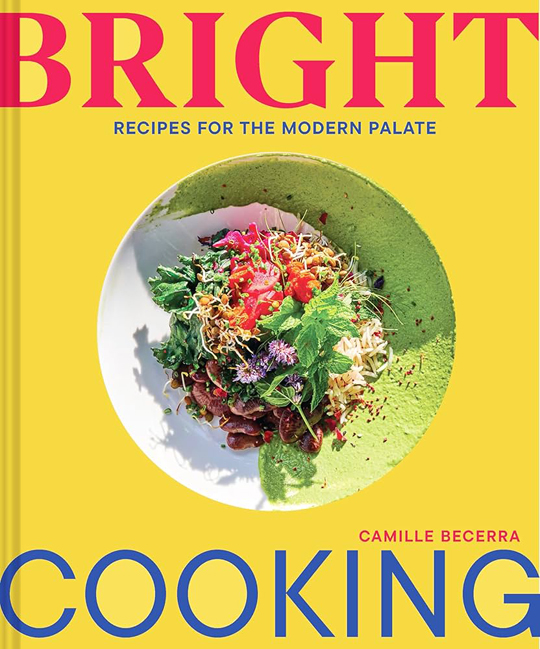
It’s a collection of more than 140 fresh tasting, vegetable-forward recipes. Learn how to make her fundamentals to enjoy on their own or in her suggested recipes.
For instance, follow her directions to make your own yogurt (with an optional vegan version) to turn into “Curry Leaf Yogurt” or “Green Goddess Yogurt” to perk up salads; whip up “Walnut Kimchi Dip” to enjoy with crudites or alongside her “Grilled or Steamed Turnips and Their Greens”; and cook up a batch of “Guava Jam or Paste” to flavor yogurt or to slather on her “Cheese Biscuits.”
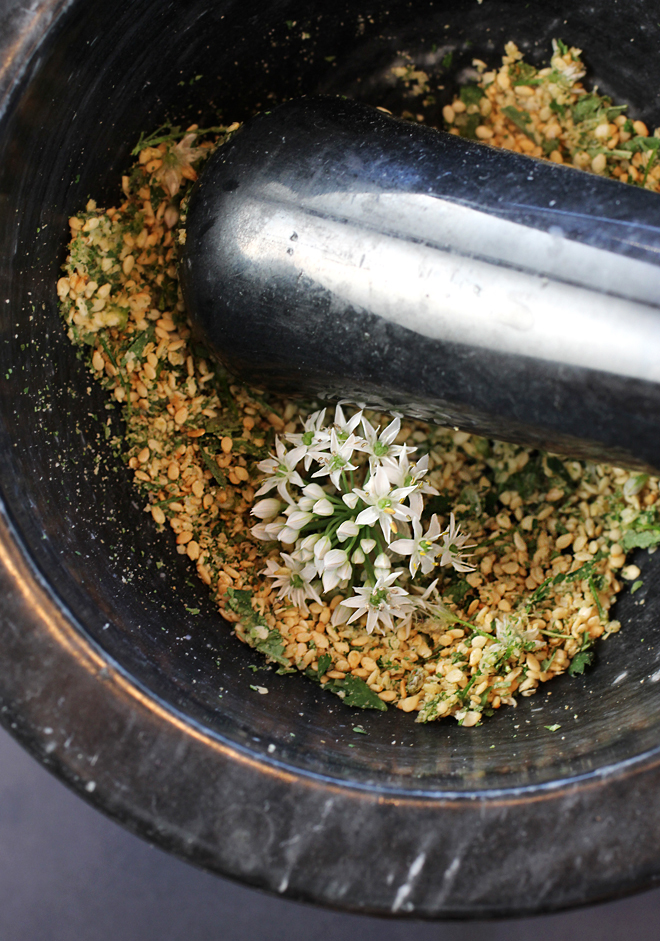
For this rice dish, you’ll need a mortar and pestle to make her “Summer Gomasio.” It’s like Japanese furikake, but includes dried summer herbs and flowers along with sesame seeds, which all get pounded together.
Becerra instructs to dry the fresh herbs on a rack for a week or use a dehydrator overnight. I turned to my microwave for a faster, easier route. After picking some fresh mint, thyme, basil leaves and chive flowers from my garden, I arranged them in one layer on a microwavable plate with one paper towel underneath and one on top. I microwaved the herbs in 20- to 30-second intervals until they turned dry and brittle. Then, they were pounded in the mortar with salt and toasted sesame seeds.
Her recipe makes far more than you’ll need for this rice dish. You can cut down the recipe. Or just keep extra gomasio on hand in a covered container to sprinkle on green salads, cold soba, or as a finishing touch to grilled fish or shrimp.
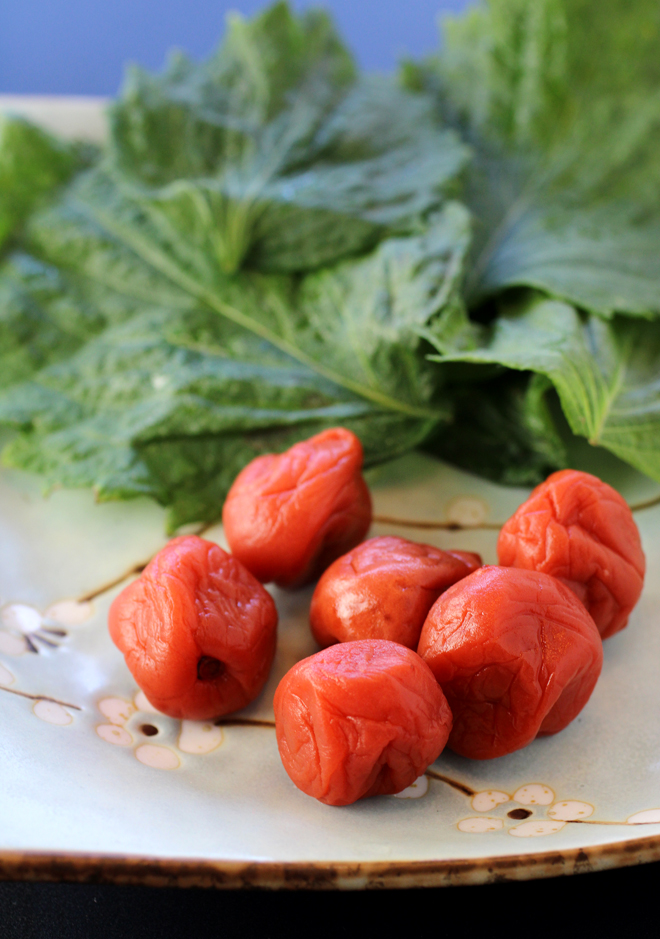
Becerra gives directions for cooking the rice on the stovetop. I “cheated” and used my trusty rice cooker instead. Feel free to do the same, if you like.
Once the rice is cooked, rested, and fluffed, spread it on a pretty serving plate, sprinkle on rice vinegar, and a generous amount of minced shiso leaves, and gently fold everything together. Lastly, drizzle on a little sesame oil, sprinkle on the gomasio, and dot with minced ume.
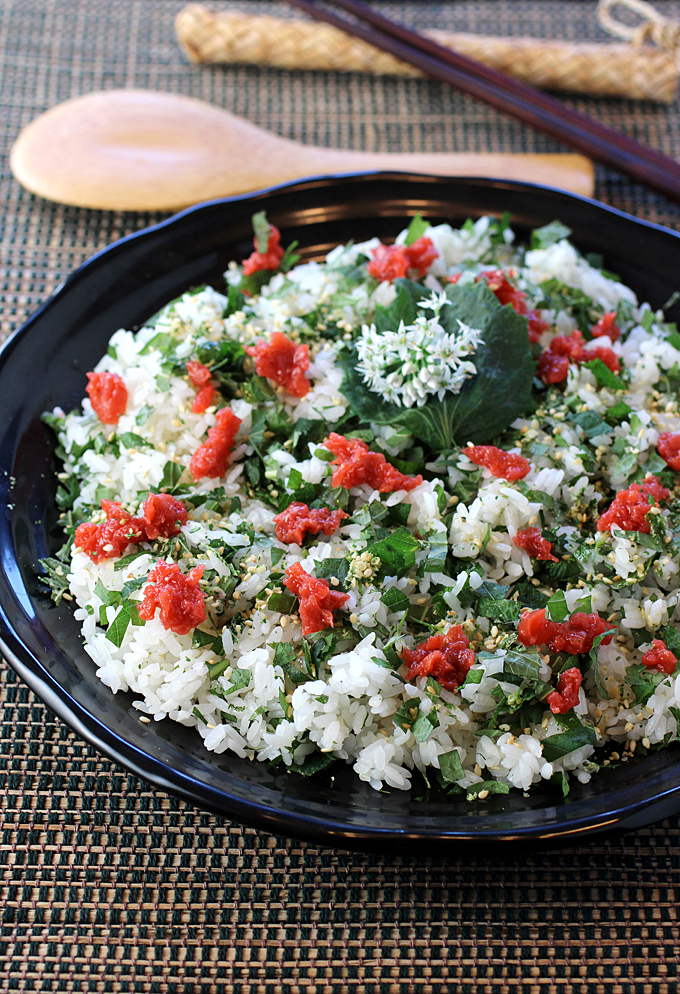
Serve alongside sashimi or simple salted grilled fish. Scoop some onto your plate to enjoy or spoon some onto a toasted nori sheet to make a hand roll. For more heft, Becerra suggests adding avocado slices, salmon roe, and pickled vegetables to the dish.
It’s a comforting dish with the sweet starchy taste of the rice a welcoming canvas for the salty-fruity pickled plum, the nutty-herby-crunchy gomasio, and the minty, slighty citrusy whoosh of the perilla leaves.
Call it down-home yet decked out all at once.
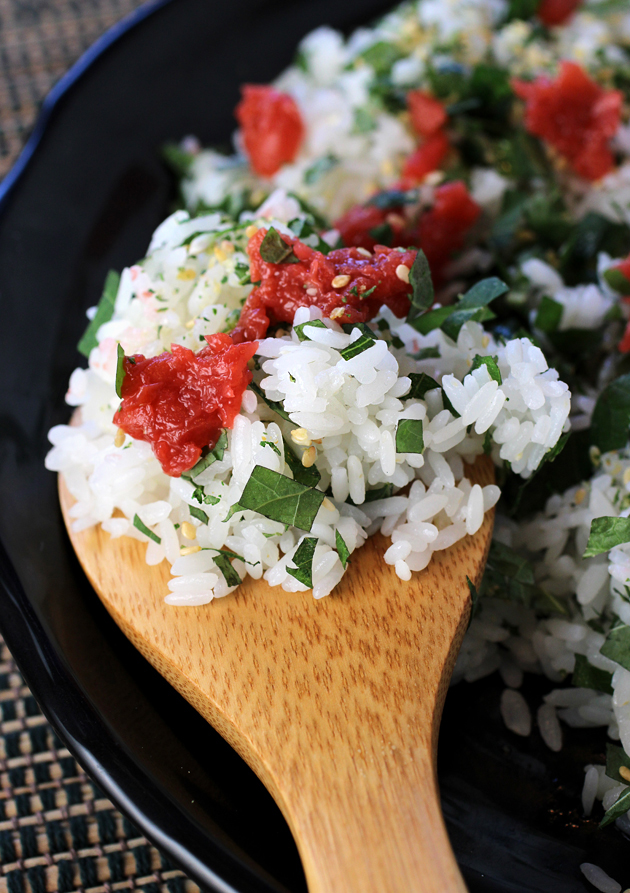
Dressed Rice with Shiso and Summer Gomasio
(Serves 2)
1 cup Japanese short-grain rice
1 1/4 cups spring or filtered water
2 pinches salt
A few shakes of rice wine vinegar
20 shiso leaves
1 tablespoon light toasted sesame oil
2 tablespoons Summer Gomasio (recipe below)
6 ume (pickled plums), pitted and finely minced
In a small sturdy pot with a lid, rinse the rice by swirling it in water a few times with your hand. Drain and repeat three times (use the milky water to water your plants rather than discarding it). Let the washed rice sit for 10 minutes.
Add the water and salt to the rice pot, cover, and simmer over medium-high heat for 5 minutes. Decrease the heat to medium-low and cook for 20 minutes. Remove from the heat. Swaddle the lid of the pot with a kitchen towel and place it back on the pot. Let the rice rest for 5 minutes. (Or alternatively, cook the rice in a rice cooker.)
Fluff the rice and transfer to a shallow ceramic serving bowl. Let sit for 5 minutes. With your thumb, cover the top of the rice wine vinegar bottle and shake over the rice, gently raining about 20 drops over the top.
Stack the shiso leaves, reserving a couple of leaves for garnish. Cut them lengthwise into super thin strips, gather the strips, and mince them finely. You can run a knife through t hem a few more times to get them super minced. Do this right before serving the rice so the shiso stays fresh and vibrant green. Fold the minced shiso into the rice.
To finish, drizzle with the sesame oil, sprinkle with the gomasio, and dot with the minced ume and reserved shiso. Serve immediately.
Summer Gomasio
(Makes 1/2 cup)
8 parsley sprigs
8 flowering herb sprigs such as mint, thyme, or basil
1/4 cup edible flowers
1/2 cup toasted sesame seeds
2 teaspoons sea salt
Gently wash the parsley, herbs, and flowers, then lay them on a flat basket or rack to dry for a week (alternatively, use a dehydrator overnight). Or make use of your microwave, by laying the herbs in a single layer on a paper towel-lined microwavable plate. Cover with another paper towel and microwave on high in 30 second spurts until herbs are dry and crumbly.
With your fingers, crumble the herbs into a mortar. Discard any stems and reserve the flower heads. Add the sesame seeds and salt and pound the pestle until most of the sesame seeds have been nicked. Add the flower heads and pound a couple of times to incorporate. This mix will keep in a lidded container for 1 month at room temperature or 3 months in the refrigerator.
Note: In late summer when everything is peaking at the market or in your gardens, grab up all the flowering herbs and edible flowers you can and dry them for later use. Flowering herbs have an extra boost of flavor, making them ideal for drying and using in this application. If none are available, dried herbs without blossoms will do fine.
Use: Use his mix as you would a standard finishing salt for salads, dips, soups, steamed vegetables, fish, and more.
Adapted from “Bright Cooking” by Camille Becerra
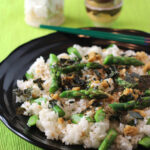
Another Japanese-Style Rice Dish to Enjoy: Asparagus and Scrambled Egg Scattered Sushi

Oh my tastebuds pucker up at the umeboshi! My grandma used to make those from unripe apricots, I loved to eat them when they were still crunchy and would get in trouble busting into her stash…. This looks delicious!
Hi Sandy: I love that memory. I can just picture it. I’d do the same as a kid whenever my parents were crisping up onions or noodles in a pan, and I’d reach in to grab a strand before they swatted my hand away. You’re lucky your grandma used to pickle her own and share her wonderful bounty.